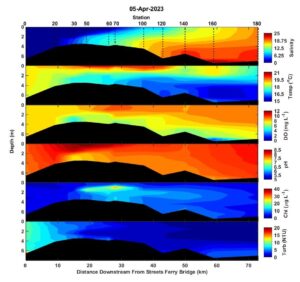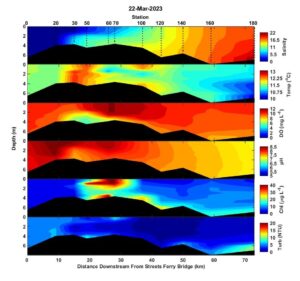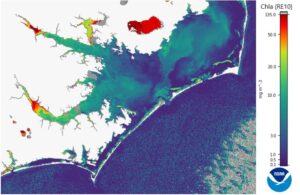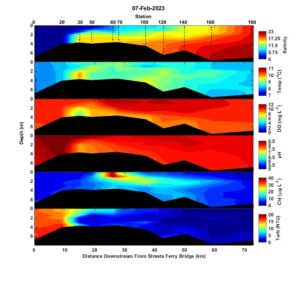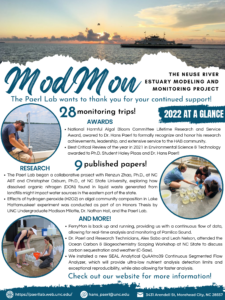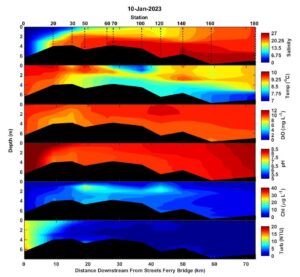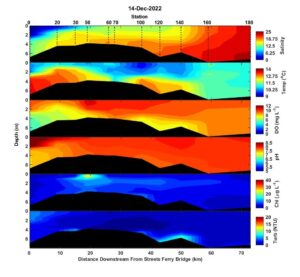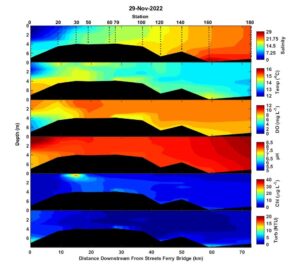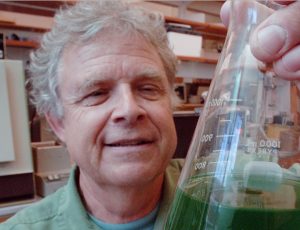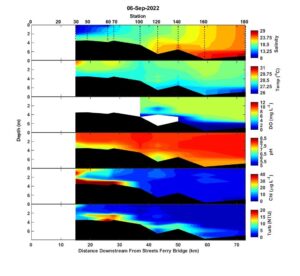
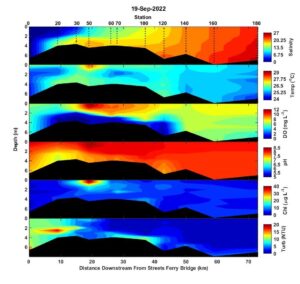
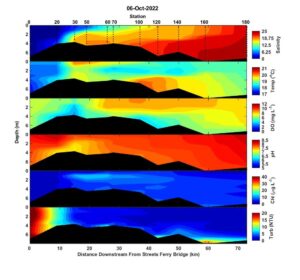
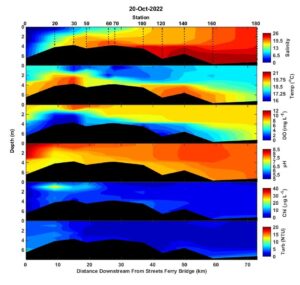
Hi all,
So far, the second half of hurricane season had done little to end the low flow, high salinity conditions in the Neuse River Estuary.
On Sep 6, surface water salinity at the mouth of the Neuse was 25 and bottom water salinity was about 29. Surface to bottom salinity differences were approximately 5 along the length of the estuary. The upper most stations were not accessible due to the railroad bridge being closed just above New Bern. Water temperatures were very warm, 26-30C. The bottom 2 meters of the water column were hypoxic from the mouth to station 100. The membrane on the dissolved oxygen probe failed after data from station 100 were collected. Phytoplankton biomass was generally less than 10 ug/L chlorophyll a except for a small zone of elevated (20-30 ug/L) chlorophyll a in surface waters and even higher chlorophyll a levels along the bottom from station 30 to station 70. Surface and bottom water samples from station 50 were microscopically examined and revealed that in both the surface and bottom there was a mixed assemblage of cryptophytes, dinoflagellates, diatoms, and a euglena. The euglena was likely the dominant species biomass-wise, followed by the dinoflagellates Levandarina fissa, and Scrippsiella trochoidea. The toxic dinoflagellate, Karlodinium veneficum, was also present, but at concentrations that are unlikely to cause fish kill problems (< 1000/mL). The main diatom was Leptocylindrus minimum.
On 19 September 2022, the salinity regime was similar to that on 6 September but the lower estuary was less stratified. Water temperatures were ~25 C, cooler by 4-5 degrees compared to 6 September. At station 50, high surface water temperatures (~28 C) also coincided with high dissolved oxygen, chlorophyll a, and pH, all conditions indicative of a bloom. I think what we’re seeing here is that high light attenuation caused by a bloom increased the solar warming of the surface layer. Bottom water dissolved oxygen conditions downstream of station 140 were normoxic but hypoxic bottom water conditions extended from station 120 upstream to the tip of the salt wedge above station 20. Bottom waters at stations 20 and 30 were truly anoxic and smelled strongly of hydrogen sulfided. The high turbidity along the halocline at these stations is likely due to the formation of mineral precipitates as dissolved iron forms iron hydroxides when it meets oxygenated waters along the halocline. Microscopic examination of station 50 surface water showed that the bloom was dominated by the same euglena observed on 6 September, the dinoflagellate Levandarina fissa, and the autotrophic ciliate, Myrionecta rubra. None of these are know to produce toxins or cause fish kills.
The Neuse River basin got several inches of rain in late September from Hurricane Ian. The resultant increased river flow decreased salinity a little. Surface salinity near the mouth was still > 20 and the salt wedge still extended upstream of New Bern. An early October cold front significantly cooled the water to less than 20C. Dissolved oxygen conditions were normoxic along the length of the estuary. There were no areas of high (>20 ug/L chlorophyll a) phytoplankton biomass observed. High turbidity (> 20 NTU) was observed at the most upstream station and probably reflects continued moderate river flows after Hurricane Ian.
On 20 October, the tip of the salt wedge extended beyond our sampling stations. Bottom water salinity at station 0 (Streets Ferry Bridge) was 4.6. That’s in the 99th percentile of bottom water salinity at station 0. Despite cool water temperatures (<20 C), hypoxic conditions (< 2mg/L) occurred at stations 20 and 30. A subsurface zone of elevated biomass occurred at ~1 m depth from stations 20 to 50. Examination of surface water from station 20 showed that the community was dominated by Cryptomonas sp. All cryptomonads are generally considered nutritious phytoplankton that rarely cause any kind of habitat/water quality issues.
Take care,
Nathan
